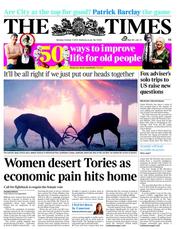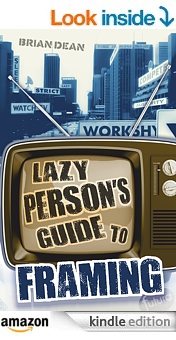The Cognitive Unconscious
The term “cognitive” has two different meanings. In traditional philosophy, it refers only to conceptual or propositional thought. But in cognitive science, “cognitive” also includes physical, bodily processes which underlie our conscious experience, and all the mental operations involved in making sense of it. The vast majority of these processes and operations are “unconscious”.
This isn’t the Freudian or Jungian “unconscious” – it’s something new in scientific terms (research-wise, starting around the 1970s). It owes more to empirical research than to sexual/poetic insights (of Freud, Jung etc).
The “cognitive unconscious” has huge implications for philosophy and psychology. And also for “media studies”. Take, for example, newspaper headlines. More often than not, they consist of a mixture of metaphor and abstraction (as in the example, above left – an “establishment” [abstraction] “on the rack” [metaphor]). From these we construct a representational “reality” of sorts – courtesy of frames in our brains. But we’re generally not aware of our own creative role in this.
“All of our knowledge and beliefs are framed in terms of a conceptual system that resides mostly in the cognitive unconscious”.
This quote is from a book on cognitive science which I’ll be making much use of: Philosophy in the Flesh, by Lakoff & Johnson. Much of it doesn’t seem new, as it uses familiar words: “unconscious”, “frame”, etc. But don’t be fooled by the familiarity.
Traditional theory of reason found false
From the Western philosophical tradition, we’ve inherited a “faculty” theory of reason, which holds that reason is a separate faculty in its own right – separate from sense-perception, etc. This is supposedly what makes us “human”. Cognitive science has shown this to be false. To give one example, our fundamental concept of causality is shaped – shaped – by the fact we have muscles which we use to exert force.
We don’t, and can’t, have full control of the categories we use in our reasoning. Although we learn new categories, we can’t consciously make major changes to the main category systems forming our “cognitive unconscious”. Much of what we regard as conceptual inference is built from basic metaphors arising from sensorimotor inference (eg the stuff that goes on in our nervous systems as we swing through the trees looking for bananas).
The extent to which metaphor structures our experience is one of the more staggering findings in cognitive science. Metaphor isn’t just about language; it’s how we think. (See here for some examples). We constantly import inferential structure from one conceptual “domain” to another – without being aware of the process. Without this metaphorical mapping, our thinking on any given topic would be practically non-existent.
Media metaphor
 Media metaphors structure our experience of “the news” and “public mood”, etc. We’re not talking just about “spin” or “propaganda” here. Take the Times headline (see left) as an example: “Women desert Tories as economic pain hits home”. Regardless of whether its claims are factually accurate, we’re given a series of metaphors shaping our thoughts in non-trivial ways (the most basic of these, “hits”, is a primary metaphor for direct causation, which I’ve written about in an earlier entry). Without such metaphors, we couldn’t reason about complex social issues.
Media metaphors structure our experience of “the news” and “public mood”, etc. We’re not talking just about “spin” or “propaganda” here. Take the Times headline (see left) as an example: “Women desert Tories as economic pain hits home”. Regardless of whether its claims are factually accurate, we’re given a series of metaphors shaping our thoughts in non-trivial ways (the most basic of these, “hits”, is a primary metaphor for direct causation, which I’ve written about in an earlier entry). Without such metaphors, we couldn’t reason about complex social issues.
Conventional media criticism highlights the dangers of factual inaccuracy, distortion, misrepresentation, “spin”, “propaganda”, “bias”, etc. One might remove all these dangers, but still have a media which shapes thinking in a certain way. In fact, “balance” (or elimination of “bias”) often describes a single metaphorical frame – but with “balanced” coverage between one side asserting the frame, and another negating it, or simply inverting it. (George Lakoff is constantly warning political campaigners that to negate a frame is to reinforce it, but one still sees the liberal media using frames which have been carefully selected and promoted by rightwing think-tanks, etc).
More crucial than this “bias”/”balance” dichotomy (in framing terms, at least) is metaphorical pluralism – applying multiple metaphors (ie diverse inferential structures) to a given issue. As individuals, most of us would probably recognise this as the “healthy norm” – it gives our thinking richness, and helps to prevent dogmatism, intolerance, etc. Mass media (and also, it should be said, some “alternative” media) tend to work against this pluralism – through metaphorical narrowing and repetition (a good example is media framing of the “unemployed” – on both right and left).


